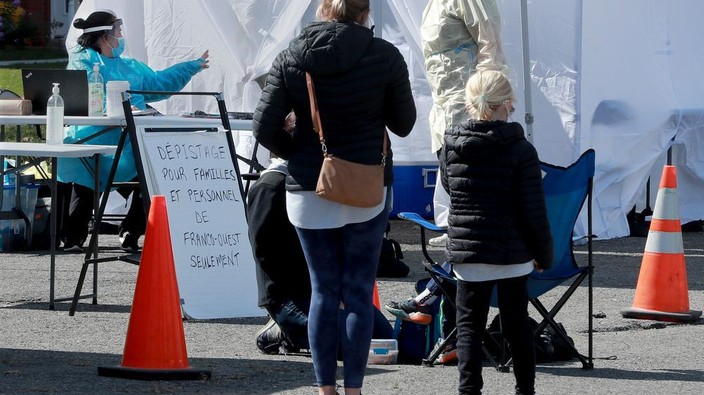opinion: more – and easier – student covid testing is needed
barriers to screening must be removed, particularly for less wealthy families.

a pop-up covid-19 testing site at collège catholique franco-ouest in nepean is shown in this september 2020 photo.
julie oliver
/
postmedia
by: dr. nisha thampi andirfan dhallathe covid-19 pandemic has disrupted the education of canadian children and youth for more than a year now. worryingly, the emergence of the more transmissible b.1.1.7 variant has started to cause havoc in many communities and an increasing number of school closures. schools are not islands, and we should not be surprised to see that increasing community prevalence of covid-19 has led to more infections among students and staff. transmission can happen in schools, but also during activities and gatherings before and after school.to preserve in-person learning while reducing covid-19 spread, we need to make it easier for parents to get themselves and their children tested quickly if they have been exposed or have symptoms. in areas where the virus is circulating widely, we should also be using covid-19 surveillance tests to screen children and staff without symptoms, as an added layer of protection.while screening surveys – the forms that students, parents and staff complete every morning – can identify individuals with infectious symptoms, about one-third of infected students will not have any symptoms, and therefore enter school unaware that they are contagious. more testing will help us understand and track transmission more accurately and put measures in place to stop it.last week, the federal expert advisory panel on testing and screening for covid-19 released a report with recommendations for testing in primary and secondary schools. resources should prioritize those most likely to be infected with covid-19 – individuals with symptoms and asymptomatic contacts identified by tracing – and those neighbourhoods where case rates have been higher and testing rates lower. in ottawa, a review of covid-19 activity in school last fall found that nearly 60 per cent of school-related outbreaks could be traced back to a student or staff member from the same household as another person with covid-19. we should be following recommendations from public health regarding household testing and isolation. however, we may still miss infections that produce few or no symptoms, particularly in communities with overwhelmed public health systems, where not all contacts can be traced quickly. this is where additional screening becomes useful.screening looks for the virus in individuals who do not have symptoms. when positive, screening tests should typically be confirmed with laboratory-based pcr tests, which can also let us know if the infection is due to a covid-19 variant of concern. a positive rapid antigen test acts as a red light – meaning that the individual and their household should isolate immediately to break a potential chain of transmission. in ottawa, mobile testing clinics with rapid antigen and diagnostic testinghave sought to identify and prevent covid-19 spread at home, in schools and communities in collaboration with school boards and cheo, to ultimately keep classes and schools open for in-person learning.the negative effects of school closures have undoubtedly been felt most by children who come from communities that have historically been marginalized. barriers need to be removed for testing and screening programs to be effective, particularly for less wealthy families. critically, in communities where covid-19 is circulating widely, testing will not stop transmission if families cannot afford the consequences of self-isolation and quarantine. given the consequences of a positive test result – exclusion from in-person learning for the student, their siblings, and their cohort, as well as restriction from in-person work for employed household members – families may be faced with an unjust choice: get tested and self-isolate to protect the public’s health, or continue to earn an income to put food on the table and make ends meet. nobody should have to choose between these options.testing has been a key risk control measure in our infection prevention toolbox throughout the pandemic, but it is not a silver bullet. other health and safety measures including distancing, masking, outdoor learning, reduced class sizes and improved ventilation: each play an important role in preventing the spread of infections in school. but more testing and screening is a useful addition to the toolbox, and can help ensure that in-person learning is maximized during the next few months.nisha thampi is a pediatric infectious disease physician at cheo, a pediatric health and research centre in ottawa. irfan dhalla is a general internal medicine physician and a vice-president at unity health toronto. he co-chairs the federal expert advisory panel on testing and screening for covid-19.
 3 minute read
3 minute read





